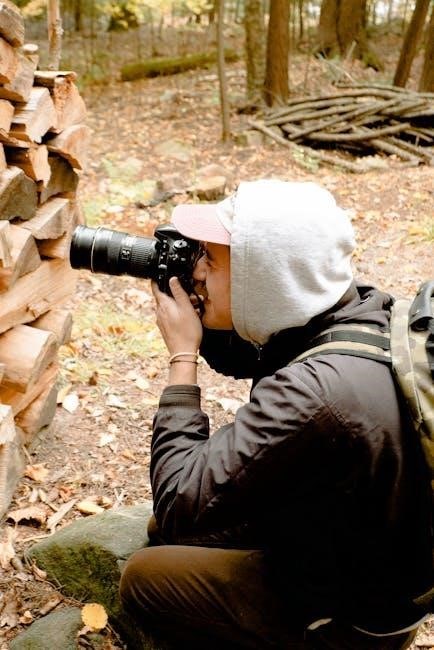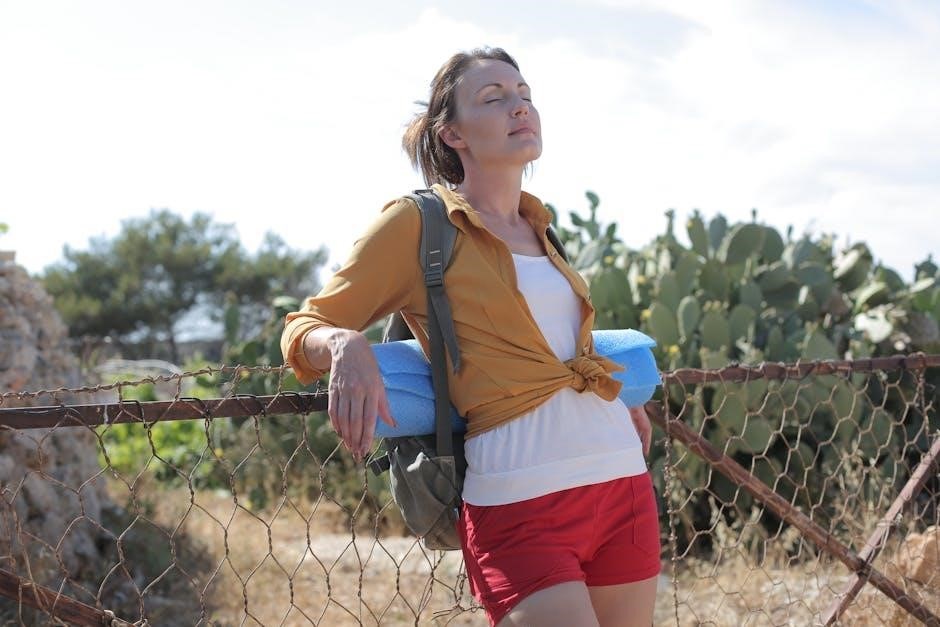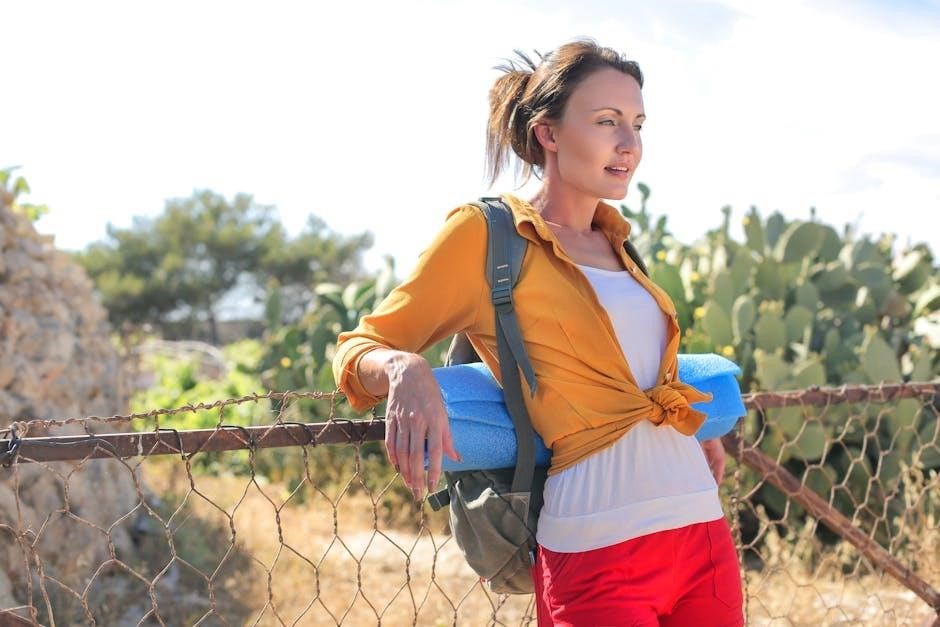Welcome to The North Face Backpack Size Guide, your ultimate resource for finding the perfect fit. This guide offers detailed size charts, measurement tips, and capacity insights to ensure your backpack matches your adventure needs. Whether for hiking, commuting, or everyday use, proper fit is key for comfort and performance. Explore men’s, women’s, and unisex options, and discover how to measure for the best fit. Learn about adjustable versus fixed sizes, materials, and maintenance to maximize your backpack’s lifespan. Use this guide to make informed decisions and enhance your outdoor experiences with The North Face.
Understanding the Importance of Proper Fit
A proper fit is essential for comfort and performance in a backpack. Ill-fitting backpacks can cause discomfort, restrict movement, and lead to poor posture or even injury. The North Face backpacks are designed to distribute weight evenly, but this is only possible if the size matches your body. Incorrect sizing can result in strained shoulders or an unstable load, especially during active use. Proper fit ensures optimal ventilation, reduces fatigue, and enhances overall performance during hikes or daily commutes. Understanding your torso, chest, and waist measurements is crucial for selecting the right size. The North Face offers adjustable and fixed sizes to cater to different body types and activities. Use their size guide to avoid common mistakes and ensure a comfortable, secure fit for your adventures.
Overview of North Face Backpack Size Options
The North Face offers a wide range of backpack sizes to cater to diverse needs and body types. From men’s, women’s, and unisex options to youth sizes, the brand ensures a tailored fit for everyone. Backpacks come in various capacities, from small daypacks (under 23 liters) to larger models (up to 140 liters) for extended trips. Sizes are often height-based, with adjustable torso options for customizable fits. Popular models like the Borealis and Assault packs feature three-size adjustable or fixed options. The size chart includes detailed measurements for torso, chest, and waist to help users choose the right fit. Whether for hiking, commuting, or everyday use, The North Face provides a size option to meet your specific requirements and ensure optimal comfort and performance.
Size Charts for North Face Backpacks
The North Face backpack size charts provide detailed measurements for men’s, women’s, and unisex options, including adjustable and fixed sizes. Capacities range from 23 to 140 liters, catering to various activities and needs. Use these charts to find the perfect fit for your adventures, ensuring comfort and functionality. Explore the options below to discover the ideal size for your next backpack.
Men’s Backpack Size Chart
The North Face men’s backpack size chart offers a detailed guide to finding the perfect fit. Backpacks are categorized by torso length, ranging from 15 to 22 inches, and chest size, typically between 34 and 50 inches. Capacities vary from 23 to 140 liters, catering to day trips, multi-day excursions, and expedition needs. Popular models like the Borealis and Assault backpacks feature adjustable torso systems, ensuring versatility. Waist belt sizes usually range from 28 to 40 inches, providing a secure fit. Consider your activity—hiking, climbing, or commuting—to choose the right size. Always refer to the specific model’s measurements for the best fit, as sizes may slightly differ across collections. Proper sizing ensures optimal comfort and load distribution during your adventures.

Women’s Backpack Size Chart
The North Face women’s backpack size chart is tailored to provide a comfortable, ergonomic fit for female adventurers. Backpacks are sized based on torso length, typically ranging from 14 to 20 inches, and chest circumference, usually between 30 and 40 inches. Capacities range from 20 to 40 liters, catering to day hikes, urban commutes, or multi-day treks. Popular models like the Women’s Borealis and Assault backpacks feature adjustable torso systems, ensuring a personalized fit. Waist belt sizes typically range from 25 to 38 inches, offering a secure, supportive fit; The designs prioritize comfort and mobility, with curved shoulder straps and hip belts. Always match your torso and chest measurements to the chart for the best fit, as sizing may vary slightly across models. Proper sizing ensures maximum comfort and performance during your adventures.

Unisex Backpack Size Chart
The North Face unisex backpack size chart offers versatile sizing options to accommodate a wide range of body types. Backpacks are typically categorized by torso length, ranging from 14 to 22 inches, and chest circumference, spanning 30 to 46 inches. Capacities vary from 20 to 45 liters, making these backpacks suitable for day trips, overnight stays, or extended expeditions. Adjustable shoulder straps and hip belts ensure a customizable fit, while unisex designs prioritize comfort and durability. Torso measurements are key to selecting the right size, as they ensure proper weight distribution. For optimal comfort, match your torso length and chest size to the chart, as unisex backpacks are designed to adapt to various frames without compromising performance or style.
Youth Backpack Size Chart
The North Face youth backpack size chart is designed for younger users, offering smaller, adjustable fits for growing bodies. Backpacks typically range in sizes from XS to L, catering to children and teenagers. Capacities vary from 15 to 28 liters, suitable for school, day trips, or light adventures. Torso lengths for youth backpacks generally range from 10 to 18 inches, with chest circumferences between 24 and 34 inches. Adjustable shoulder straps and hip belts provide a secure fit, while lightweight materials ensure comfort. Popular youth models include the Recon and Borealis Jr., featuring kid-friendly designs with reflective safety elements. Match your child’s torso and chest measurements to the chart for the best fit, ensuring comfort and functionality for everyday use or outdoor exploration.

How to Measure for the Perfect Fit
To ensure a proper fit, measure your torso, chest, and waist using a flexible tape measure. Stand up straight and measure around your natural waistline where the backpack will sit. Accurate measurements help determine the correct size and ensure optimal comfort and weight distribution.
Measuring Your Torso
Measuring your torso is crucial for determining the ideal backpack fit. To measure accurately, locate the C7 vertebra at the base of your neck and the top of your hip bones. Place a flexible tape measure horizontally around your body at these two points. Ensure the tape is level and not twisted. The measurement should reflect the natural curve of your spine. If the tape sits too high or low, the fit will be off. Proper torso measurement ensures the backpack’s shoulder straps and hip belt align correctly, providing optimal comfort and weight distribution. Always stand upright during measurement for accuracy. This step is essential for selecting the right size and ensuring your backpack feels comfortable during extended use. Accurate torso measurement is the foundation of a perfect fit.
Measuring Your Chest
Measuring your chest is essential for ensuring a comfortable and secure fit with your North Face backpack. To measure accurately, place a flexible tape measure around the widest part of your chest, typically just under your armpits and across your nipple line. Ensure the tape is level and not too tight or loose. Stand upright and take a deep breath to allow for natural chest expansion. Record the measurement to determine the appropriate chest strap adjustment. For backpacks with a built-in chest strap, this measurement ensures proper positioning and comfort. Accurate chest measurement helps prevent restrictive straps and ensures even weight distribution. This step is vital for optimizing your backpack’s fit and performance during outdoor activities. Proper chest alignment enhances overall comfort and usability. Always measure over the clothes you plan to wear while using the backpack. This ensures the best fit for your specific needs.
Measuring Your Waist
Measuring your waist is a key step in determining the best fit for your North Face backpack. To measure accurately, locate your natural waistline, typically just above your hip bone. Use a flexible tape measure and wrap it around this area, ensuring it is level and not twisted. Stand upright and relax your stance to get an accurate reading. The waist measurement helps determine the proper placement of the backpack’s hip belt, which is crucial for weight distribution and comfort. For the most precise fit, measure over the clothing you typically wear while hiking or backpacking. This ensures the hip belt sits correctly and provides optimal support; Accurate waist measurement is essential for maximizing comfort and performance during your outdoor adventures. Proper fit prevents discomfort and ensures even load distribution. Always double-check your measurement for accuracy. This step is vital for your backpack’s overall functionality and comfort.
Measuring Your Neck
Measuring your neck is another important step in ensuring a proper fit for your North Face backpack. To measure accurately, wrap a flexible tape measure around the base of your neck, just above your Adam’s apple. Stand upright and keep your shoulders relaxed to get an accurate reading. The neck measurement helps determine how the backpack’s shoulder straps will sit comfortably around your neck and shoulders. Proper alignment prevents strain and ensures the weight of the backpack is distributed evenly. For the best fit, measure over the clothing you typically wear while backpacking or hiking. This ensures the shoulder straps rest correctly and provide optimal comfort. Accurate neck measurement contributes to a more enjoyable and strain-free outdoor experience. Always double-check your measurement for precision. This step is essential for your backpack’s overall comfort and performance. Proper fit ensures maximum efficiency during your adventures.
Capacity and Dimensions
Capacity and dimensions are crucial for determining a backpack’s functionality and fit. Understanding these ensures the backpack meets your needs without compromising comfort or practicality.

Understanding Backpack Capacity
Backpack capacity refers to the internal volume of a bag, measured in liters, determining how much gear it can hold. For North Face backpacks, capacity ranges from 10L to 40L+, catering to day trips, multi-day adventures, or urban use. Smaller capacities (10-20L) are ideal for essentials like a laptop, water bottle, and extra layers, while larger packs (30L+) are designed for extended trips, carrying sleeping bags, or heavy gear. North Face offers models with multiple compartments to organize items efficiently, ensuring optimal use of space. When choosing, consider your activity, duration, and the size of your gear to select the right capacity. Proper capacity ensures comfort and convenience without overpacking or underpacking.

Comparing Dimensions Across Models
North Face backpacks vary in dimensions to suit different needs, with sizes ranging from compact daypacks to large expedition bags. Dimensions include height, width, and depth, influencing how the backpack fits and carries. Smaller models like the Borealis (18.5″ x 11.5″ x 9.5″) are ideal for urban or school use, while larger packs like the Assault (22″ x 11″ x 9″) cater to outdoor adventures. When comparing, consider your torso length, activity type, and gear size to ensure proper fit and comfort. Adjustable features like torso lengths and load lifter straps enhance customization. Always check the product specs to match the backpack’s dimensions with your intended use and body size for optimal performance.

Best Practices for Choosing the Right Size
Best practices include considering torso size, intended activity, and adjustable features. Test the fit with gear and ensure proper load distribution for optimal comfort and functionality.
Considering Your Activity and Needs
Choosing the right backpack size begins with understanding your activity and needs. For hiking or backpacking, prioritize a snug fit and torso-specific sizing to ensure comfort under heavy loads. If commuting or traveling, consider a slightly larger capacity for organization and accessibility. Assess the gear you’ll carry regularly, such as laptops, water bottles, or extra layers, to determine necessary compartments and pockets. Adjustable straps and features like hip belts or chest straps can enhance fit and comfort for specific activities. Match the backpack’s capacity to your gear requirements without overpacking, as this can affect both fit and mobility. Always align the backpack’s intended use with your lifestyle to maximize functionality and comfort.
How to Avoid Common Sizing Mistakes
To avoid common sizing mistakes, always refer to North Face’s official size charts and measure yourself accurately. Many people overlook torso length, assuming it aligns with shirt size, but it’s crucial for backpack fit. Avoid guessing your size based on previous purchases, as models vary. Test the backpack with the gear you’ll typically carry to ensure capacity matches your needs. Don’t ignore adjustable features; they can fine-tune the fit. Lastly, consider the backpack’s intended use—daypacks and expedition packs have different sizing priorities. By aligning your measurements and needs with the size guide, you’ll find a backpack that offers both comfort and functionality for your adventures.
Popular North Face Backpack Models
Explore popular models like the Borealis and Assault backpacks, known for durability and functionality, each with tailored size guides to match user preferences and activities.
Borealis Backpack Size Guide
The Borealis Backpack is a popular choice for its versatility and durability, catering to both everyday use and outdoor adventures. Available in sizes tailored for men and women, the Borealis features a torso range of 18-22 inches for men and 15-19 inches for women. Chest sizes typically range from 38-46 inches for men and 32-40 inches for women. The backpack offers capacities of 27-30 liters, making it ideal for day trips or extended excursions. Key features include padded shoulder straps, a breathable back panel, and multiple compartments for organization. The hip belt and adjustable torso ensure a customizable fit, but sizing may vary slightly depending on body proportions. Measuring your torso and chest accurately is crucial for the best fit. The Borealis is renowned for its ergonomic design and load management capabilities, making it a favorite among hikers and commuters alike.
Assault Backpack Size Guide
The North Face Assault Backpack is designed for tactical and professional use, offering durability and functionality. Sizes range from Small to Large, with torso measurements typically spanning 16-20 inches for Medium and 18-22 inches for Large. Weight capacity varies by model, but most Assault Backpacks weigh between 3.5-4 pounds. Dimensions generally measure 21x12x8 inches, providing ample storage without compromising mobility. Features include MOLLE-compatible systems, padded shoulder straps, and reinforced construction. The Assault Backpack is ideal for heavy-duty applications, such as military or first-responder use. When selecting a size, consider torso length and hip belt fit for optimal comfort. Always refer to The North Face’s official size chart for precise measurements. This backpack is a top choice for those needing rugged reliability and versatility in demanding environments.

Additional Considerations
Adjustable straps ensure a customizable fit, while high-quality materials like nylon enhance durability. Compression features help secure items, maximizing space and comfort during extended use.
Understanding Adjustable vs. Fixed Sizes
Adjustable backpacks offer customizable fits through features like shoulder straps and hip belts, catering to varying torso lengths and body types. Fixed-size backpacks, however, are designed for specific measurements, providing a more tailored fit. Adjustable options are ideal for shared use or growing needs, while fixed sizes suit those with precise fit requirements. Consider your activity level and how often you’ll adjust the backpack. Adjustable models may add bulk but offer versatility, while fixed sizes prioritize lightweight performance and durability. Choose based on your lifestyle and whether flexibility or precision is more important for your adventures.

The Role of Materials in Fit and Comfort
Materials play a crucial role in determining the fit and comfort of North Face backpacks. Lightweight fabrics like nylon and polyester enhance mobility, reducing strain during extended use. Padded shoulder straps and hip belts made from breathable, moisture-wicking materials improve comfort by reducing sweat buildup. Durable constructions ensure structural integrity, maintaining the backpack’s shape and distributing weight evenly. Reinforced stitching and weather-resistant coatings add longevity while keeping the bag lightweight. The choice of materials directly impacts how the backpack conforms to your body, ensuring optimal support and flexibility. Premium materials not only elevate performance but also provide a more personalized fit, making each backpack suitable for specific activities and preferences.

Customer Support and Sizing Help
The North Face offers dedicated customer support to assist with sizing inquiries. Their team provides personalized recommendations, size charts, and fit guides to ensure the best experience.
Customers can contact them via phone, email, or live chat for tailored advice. Additionally, in-store experts are available to help you find the perfect fit.
Their website also features detailed size guides and videos to simplify the process. Reach out to their support team for any sizing concerns or questions.
How to Contact North Face for Sizing Advice
To seek sizing advice, visit The North Face official website and use the live chat feature for immediate assistance. You can also call their customer service hotline, available 24/7, or send an email through their contact form.
For in-person guidance, visit a local The North Face store and consult with knowledgeable staff. Their team is trained to help you find the perfect fit based on your needs and measurements.
Additionally, The North Face website provides a “Contact Us” page with detailed options, including phone numbers and email addresses for different regions. Reach out to their experts for personalized sizing recommendations.
Maintenance and Care
Regularly clean your backpack with mild soap and water. Avoid harsh chemicals. Air dry to prevent mold. Store in a cool, dry place to maintain shape.
How to Maintain Your Backpack’s Shape
Maintaining your North Face backpack’s shape requires proper care and handling. Start by avoiding overstuffing, as this can stretch or deform the material. Use the backpack’s internal compression straps to keep items snug and evenly distributed. When not in use, store it in a cool, dry place away from direct sunlight to prevent fading or warping. Avoid leaving it compressed under heavy objects, as this can alter its structure. Clean the backpack regularly with a soft cloth and mild soap to remove dirt and stains. Allow it to air dry completely to prevent mold or mildew. For added support, consider storing it with some padding or keeping it slightly stuffed to retain its shape. Regular maintenance ensures your backpack remains functional and retains its original form for years.
Selecting the right North Face backpack size ensures comfort, durability, and optimal performance. By understanding fit, capacity, and care, you’ll confidently choose the perfect backpack for your adventures.
Final Tips for Selecting the Perfect Backpack
When choosing the ideal North Face backpack, prioritize your primary use case—whether for hiking, school, or daily commuting. Measure your torso, chest, and waist accurately to ensure a proper fit, as backpacks are designed to sit comfortably on your body. Consider the differences between men’s, women’s, and unisex options, with men’s often being larger and women’s more fitted. Assess your capacity needs by estimating the volume of your essentials, aiming for a balance between space and weight. Opt for durable materials if backpacking in rough terrain, or lightweight, breathable fabrics for everyday use. Adjustable straps offer flexibility, while fixed sizes provide a precise fit. Lastly, avoid sizing mistakes by not guessing your size, and seek advice from North Face’s customer support for personalized recommendations. Taking these steps ensures you find a backpack that offers both comfort and functionality for your adventures.